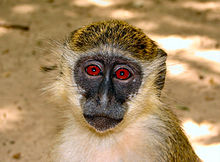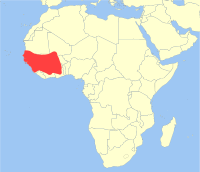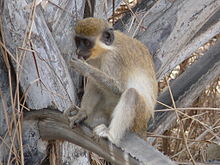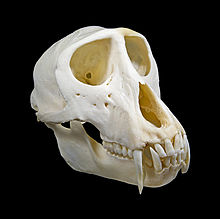- Green monkey
-
This article is about the primate of the Cercopithecidae family. For the Thoroughbred racehorse, see The Green Monkey.
Green monkey[1] 
Green Monkeys have black facial skin with golden-yellow whiskers. Conservation status Scientific classification Kingdom: Animalia Phylum: Chordata Class: Mammalia Order: Primates Family: Cercopithecidae Genus: Chlorocebus Species: C. sabaeus Binomial name Chlorocebus sabaeus
(Linnaeus, 1758)
Geographic range The green monkey (Chlorocebus sabaeus), also known as the Callithrix monkey,[3] is an Old World monkey with golden-green fur and pale hands and feet.[4] The tip of the tail is golden yellow as are the backs of the thighs and cheek whiskers.[4] It does not have a distinguishing band of fur on the brow, like other Chlorocebus species, and males have a pale blue scrotum.[4] Some authorities consider this and all of the members of the genus Chlorocebus to be a single widespread species, Cercopithecus aethiops — confusingly, the name "green monkey" has also been used for this single species.
Range, habitat and behavior
The green monkey is found in West Africa from Senegal to the Volta River. It has been introduced to the Cape Verde islands off north-western Africa, and the West Indian islands of Saint Kitts, Nevis, Saint Martin, and Barbados.[1] It was introduced to the West Indies in the late 17th century when slave trade ships traveled to the Caribbean from West Africa.[4]
It occurs in a wide range of wooded habitats, ranging from very dry Sahel woodland to the edge of rainforests. It is also commonly seen in coastal regions, where known to feed on seashore foods such as crabs.[3] It also takes a wide variety of other foods, including fruits and invertebrates. As other members of the genus Chlorocebus, the green monkey is highly social and usually seen in groups.[3]
References
- ^ a b Groves, C. (2005). Wilson, D. E., & Reeder, D. M, eds. ed. Mammal Species of the World (3rd ed.). Baltimore: Johns Hopkins University Press. pp. 158-159. OCLC 62265494. ISBN 0-801-88221-4. http://www.bucknell.edu/msw3/browse.asp?id=12100514.
- ^ Kingdon, J. & Gippoliti, S. (2008). Chlorocebus sabaeus. In: IUCN 2008. IUCN Red List of Threatened Species. Downloaded on 4 January 2009.
- ^ a b c Kingdon, J. (1997). The Kingdon Guide to African Mammals. Academic Press Limited, London. ISBN 0-12-408355-2.
- ^ a b c d Cawthon Lang, K. A. (2006). "Primate Factsheets: Vervet (Chlorocebus) Taxonomy, Morphology, & Ecology". http://pin.primate.wisc.edu/factsheets/entry/vervet. Retrieved 2007-08-13.
This Old World monkey-related article is a stub. You can help Wikipedia by expanding it.



